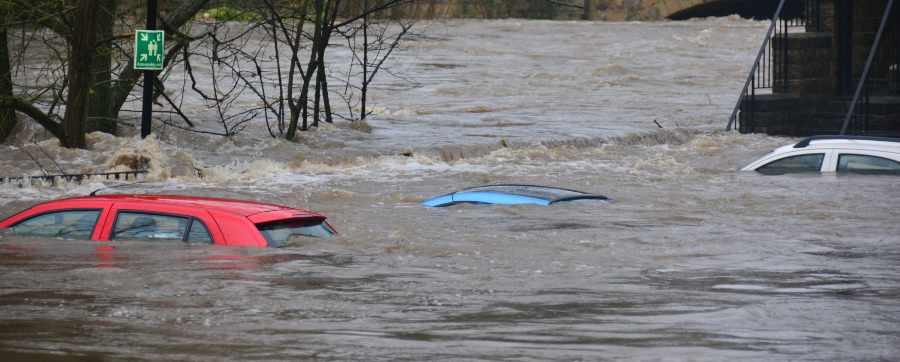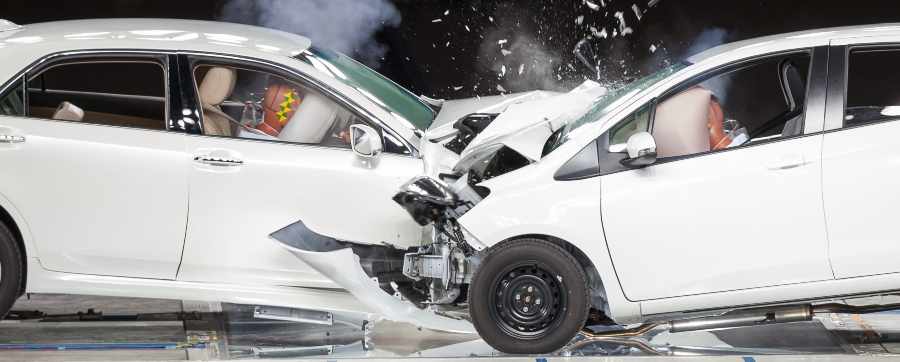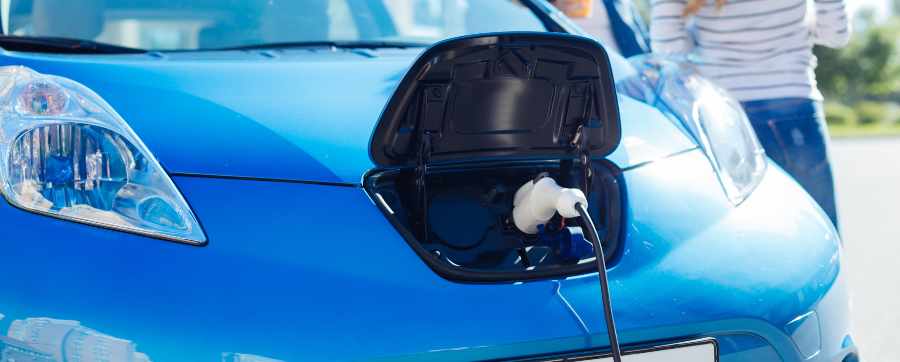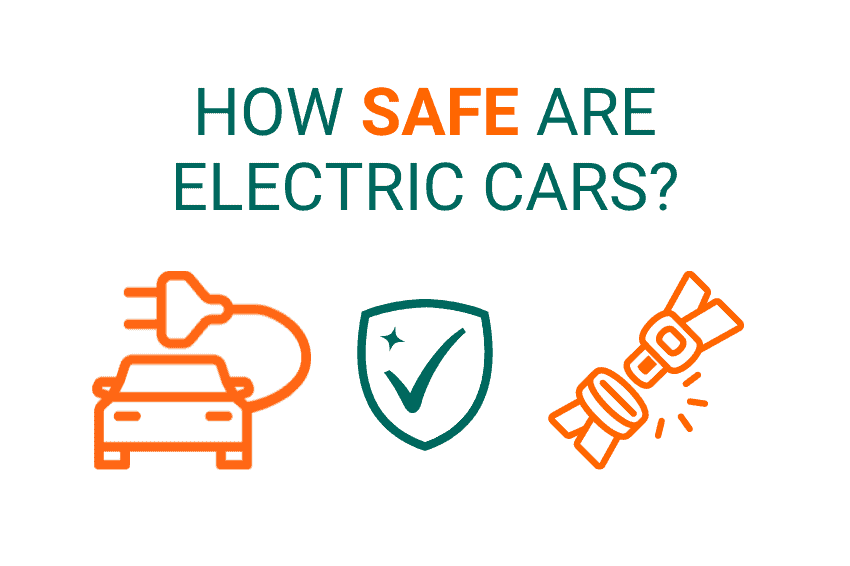Does electric car safety scare you? Nearly as much as paying tax? Only joking, that’s a much scarier topic. But seriously, we need to alleviate the worries surrounding driving electric vehicles (EVs).
If the question ‘How safe are electric cars?’ is stopping you from getting the electric car you dream and desire to drive, then keep on reading. We will tackle this anxiety together!
Are electric cars safe to drive?
So, the first thing you may question is whether EVs are even safe to drive. They are very safe to drive. If not, arguably even safer than the traditional internal combustion engine (ICE) car.
There are many misconceptions about the difference between electric and non-electric cars, but there are in fact many similarities as well as technological improvements in EVs.
What about changing a tyre on an electric vehicle? This is the same as changing a tyre on any other standard vehicle.
Most EVs come with a space-saver tyre, this is essentially a smaller, but still functional, tyre that weighs very little – as a heavy tyre will suck up the vehicle’s electric range.
However, many non-electric vehicles no longer come with a spare tyre in the boot ready for emergencies. They usually will provide a canister, which will fill the tyre with foam in the event of a breakdown.
If you prefer to have a spare tyre you now have to purchase this separately on top of buying the ICE car itself. Whereas with electric cars this isn’t the case.

According to EuroNCAP, electric cars are doing very well in terms of safety ratings. The Polestar 2 is the safest electric car and the safest car overall of 2021! Not bad, eh? Looking for a safe EV? Read our article on the top 5 safest electric vehicles.
How safe are electric cars in floods?
So, we’ve covered electric cars being safe to drive, but what about in floods? Can electric vehicles handle floods? You may have guessed it, but electric cars can indeed drive through floods.
As you may well know, a conventional petrol or diesel car suffers in floods because its engine fills up with water, ruining the car pretty much indefinitely. But with an electric car, there is no engine to flood.
Usually when a conventional ICE car is flooded there are a number of things affected by water impact:
- Exposed metal and bodywork can begin to rust
- Infotainment and other electric appliances can pose a risk of electric shock after flooding
- The brakes and clutch are damaged because there is now less friction between the two moving parts
- The most known problem is Hydrolock which is when the engine is flooded with water pretty much ruining the pistons and combustion cycle.

An electric vehicle, however, poses minimal risks to the vehicle when exposed to flooding and water damage. The infotainment system could be damaged, but this shouldn’t be the case as all electrical circuits are isolated and sealed.
You may be thinking, “what about the EVs battery?” Well, you see, the battery is also sealed and protected, so any contact with water should not cause any electrical hazard to the driver, passengers or any by-passers.
You can drive electric cars out in the rain without any issues. This is because the cars must be engineered to be waterproof so they can handle all types of weather.
So, it’s likely to experience less damage, and therefore, may not be as worthless as an ICE vehicle that has been flooded.
The most likely damage you may see in an electric vehicle from a flood is the paintwork and possibly the infotainment system.
What about the health risks? You may experience:
- Battery fire risk
- Electrocution risk
Although there are fewer risks in terms of damage to your electric vehicle compared to a petrol or diesel car, we would not recommend intentionally driving it through large levels of water as it can not only cause damage but also pose serious health and life risk.
The best advice we can give is to avoid driving through large levels of water, which of course, can sometimes be unachievable thanks to the lovely weather we get in the UK.
If you must enter the water, we would recommend only letting water levels reach half the height of the tyre.
What about if your electric vehicle has been flooded? What should you do?
Do not at any point try to start the car.
If your car is not in a safe place to dry out, contact a towing company as soon as possible so that the vehicle can be moved to a safer place.
Make a note of the initial damage you’ve spotted, how high the water rose in your car and if it was salt water that flooded the vehicle.
Why is this?
Depending on how high the water rose around your car, it may have entered the interior. If this has happened you’ll need to treat any possible mould and water damage.
Additionally, saltwater negatively affects your vehicle’s paintwork and electronics. So, when it comes to having a conversation with your insurance company, the more information you have the more it will help with your claim.
How safe are electric cars in a crash?
So, now you know your EV has the potential to survive in a flood. What about accidents? How safe are electric cars in a crash? It’s likely you’re imagining a dramatic explosive scene with flames flying to Mars and back.
Well, we can reassure you that electric cars are generally, actually, safer than the conventional internal combustion engine vehicle in a crash.
Due to the lack of gasoline in EVs, there is a huge reduced risk of an explosive episode if something were to catch alight. This is usually the sole cause of any type of explosion in a petrol and diesel car accident, thankfully, not with EVs.

Interestingly, a recent study on vehicle fires found that petrol and hybrid vehicles collectively had 4,983 fires per 100K sales, whereas electric vehicles had just 25 fires per 100K sales.
So, if this is telling us anything, is that going electric is in fact the safer option.
Additionally, all electric cars are fitted with safety features to shut the vehicle down in the case of an accident – similar to how there are safety features in a car to stop the flow of petrol in an accident.
Many EVs provide safety features to prevent an accident from taking place, including:
- Lane-keeping aid – this prevents you from leaving the lane you are driving in. How does it do this? It applies to steer torque to direct you back to the centre of the lane
- Autonomous emergency braking – This helps you stop your vehicle in the event of an emergency. How? It constantly scans the road ahead and jumps in if the driver doesn’t take action in a collision.
- Forward collision warning – Similarly, this one makes you aware of any potential collisions coming up, it does this by scanning vehicles around you that have stopped or are slower than your vehicle speed
- Distance alert – This system helps the driver become aware when they’re driving faster than the vehicle ahead, this works above speeds of 20mph.
- Tyre pressure monitor – this monitors the air pressure inside of your tyre in real-time, if it needs filling up with air the car usually shows a low-pressure warning light, gauge or a pictogram display
- Electronic stability programme – prevents the car from sliding or spinning if travelling around bends too fast. How? The wheels have sensors that detect the beginning of a slide or spin and apply small amounts of braking to the individual wheels needed
- Attention assist – this analyses the driver’s behaviour to learn about your habits and will detect any small errors you make which tell it you may be feeling drowsy, it will then suggest pulling over to take a break
- Swerve support – this helps you drive

In the worst-case scenario, if an EV does catch alight, it could emit toxic fumes which if inhaled directly will pose a serious health threat.
The best thing to do is contact the fire brigade and ensure anyone near keeps their distance from the vehicle, around 15 meters is your best bet.
A lot of EV batteries contain an air-cooling system to prevent them from overheating and causing any kind of fire or in very rare cases an explosion.
Overall, it would appear that safety is just as good if not better than an ICE vehicle. Just remember, if anything does go wrong, leave it to the experts, don’t try to fix it yourself.
What if your electric car breaks down?
This is dependent on the breakdown company you are covered by and why your car has broken down. According to the AA, you’ll be met with a team of trained EV mechanics who will be ready to assist you with your breakdown issue.
Do not at any point attempt to jumpstart your electric car. This should only ever be done by a trained professional. Trying to do so without a doubt will cause negative or even fatal life effects.
If your battery has run out, your vehicle will be towed to either the nearest charging point or your destination. Although it’s worth noting that towing your electric car can cause serious damage to the motor, the best thing to do is place the vehicle on a truck if possible.
What about EV charging safety?
So, now you know what could happen in the event of a breakdown or if your car battery goes flat. What about when you come to charge your electric vehicle? Can it become unsafe and what are the risks?
There are a few things to be aware of when it comes to charging your electric vehicle:
- Don’t daisy-chain extension leads – this is where you plug multiple extension leads into one another which poses a massive risk of fire and electric shock
- Regularly check your charging for wear and tear to prevent any electric shock or poor charging
- Don’t use multi-socket extension leads – if absolutely necessary you can use an outdoor extension lead such as a reel cable
- Book in with a professional to check the wiring in your home is strong enough to support and charge an electric car as old wiring can pose a fire risk

How safe are electric cars?
So, we’ve covered everything from safely charging your electric vehicle to what can happen if your car is flooded. Here are the key things you will have hopefully taken away from this:
- Your EV can handle floods due to no engine
- Most EVs come with a spare space-saver tyre when you buy it
- With no fuel, EVs are less likely to catch alight
- You will benefit from many safety features preventing the risk of accidents
- Autonomous technology has the potential to save lives
Our aim was to ease your worries in relation to how safe electric cars are. Hopefully, by now, the question ‘How safe are electric cars’ doesn’t faze you and you have overcome any anxiety around the safety of EVs.
You are in fact now excited to electrify your driving and get your desired electric car on the road. Not quite there yet? That’s okay. We have a team of vehicle specialists ready to answer all your burning questions about EVs.


